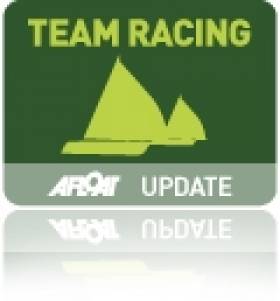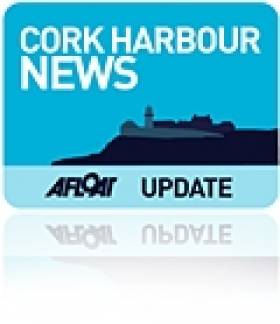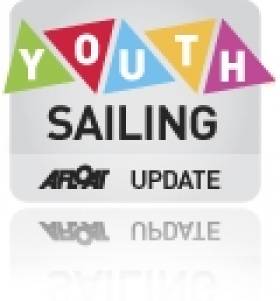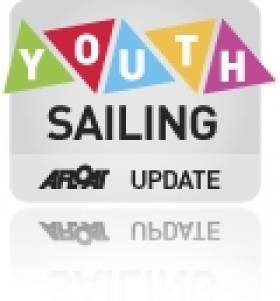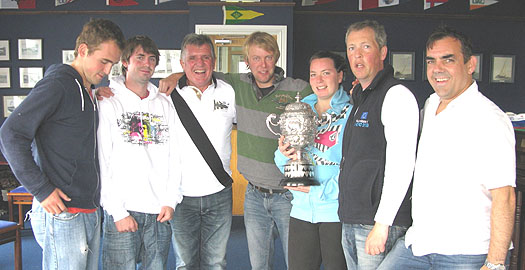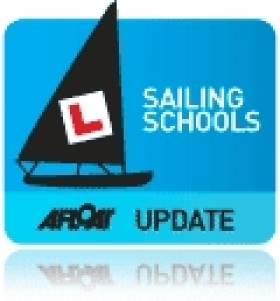Displaying items by tag: Royal Cork Yacht Club
#wmr – The Petit Final led off today and provided a brilliant introduction to the display of match racing that was enthralling for the spectators to watch today writes Claire Bateman. Caroline Sylvan (SWE) put up a tough fight against Stephanie Roble (USA), but the American crew proved to be strongest at the end. With two straight wins they secured the bronze in the 2014 ISAF Women's Match Racing World Championship, the first event out of five on the 2014 Women's International Match Racing Series.
Finally the climax of this outstanding match racing event arrived and all were waiting with bated breath expecting a tremendous fight that lived up to all expectations and provided a display unequalled on the Cork Harbour scene for a number of years. Following a short delay to allow for the swopping of Stephanie Roble's (USA) boat, who in fact had come third in the series thus taking the bronze spot, all was in readiness and the scene set for the epic battle of the week and this in fact was what it turned out to be. With SSW breeze of 15 to 25 knots, a flooding tide, sunshine and shifty winds Anna Kjellberg of Sweden, World No. 2 and Camilla Ulrikkeholm World No. 1 entered the ding dong competition.
Ulrikkeholm gained an early advantage by winning the first match of the final. The flukey winds together with the flooding tide and strong current, really put it up to the sailors who gave it their all with a masterful display which was to last through the races for the final.
In the second match it was Kjellberg got through to victory and thus leaving it all to play for in match 3. Both teams started aggressively in race 3 with both clearly stating their intention to do the business. The Dane appeared to be in control of the situation when the Swede had a poor bottom mark rounding and it looked to be all over for her. However, the wily Swede went up the right side the beat and it paid off handsomely for her, taking the lead from the Dane and then held on in very tight circumstances and took the win.
Race 4 started with the tide turned. The start was again very aggressive with the Swede appearing to have the better of it. The wind seemed at it's strongest for this race. Both boats drag raced up the beat heading left. The Dane appeared marginally faster in the stronger conditions and got through. The pattern continued until the bottom mark when the Swede, who clearly wanted the right side of the course, threw a couple of dummy tacks to break the Dane's tight cover. Five minutes of racing later and it was all over bar the shouting. The smooth water on the right and a lucky shift took the Swede past the Dane and once through she never looked like losing and so it proved to be with the Swede taking the right hand side of the course downwind and gybing in the strongest breeze to power through to the finish and taking the winner's title in the final of the 2014 ISAF Women's Matching World Championships.
The prize giving followed in a very excited atmosphere with all very glad to be finished after a grueling week and showering the winner with congratulations and good wishes. A very lovely little human touch was added and made a perfect ending to the ceremonies when by kind permission of ISAF, Anna Kjellberg's little five week old daughter, Vera, was brought out to join with her mother to receive her very own gold medal to mark the auspicious occasion.
A wonderful end to a wonderful week.
ISAF Press Release
Olympic sailor and World #2 Anna Kjellberg of the Royal Gothenburg Yacht Club was crowned 2014 ISAF Women's Match Racing World Champion in Cork Harbour this afternoon. Together with her crew – Karin Almquist, Vanja Lundberg and Annika Carlunger – the Swede defeated Danish World #1 Camilla Ulrikkeholm (DEN) 3 – 1 in their Scandinavian battle off Crosshaven, the home of the world's oldest yacht club.
"This is absolutely incredible. We've never before sailed a regatta with such a great crew feeling," the Swedish skipper smiled. "The last few weeks of my life have been completely crazy, giving birth to my daughter just five weeks ago, and now this," she said, laughing and shaking her head.
With three victories needed to win the final of the 2014 ISAF Women's Match Racing World Championship, Ulrikkeholm gained an early advantage by winning the first match of the final. Strong but very shifting and puffy winds, together with a swift current, put the sailors to the test. The second meeting ended in a fierce fight around the course, but Kjellberg kept control and passed the finish line one boat length ahead of her opponent.
When the Swedes won the third match, they put Ulrikkeholm under great pressure to break back. In the fourth match the Danes got away ahead, but didn't cover the Swedes well enough on the second upwind. Kjellberg was allowed to tack away for clear air, found an advantageous wind shift and passed into a leading position which she was able to maintain to the finish.
"We've improved in every match during this regatta, and we know that in match racing it's never over until it's over. I think we had the right nerves today, with a rather calm feeling in the boat even when the competition was tough," Kjellberg analysed after her golden match.
On her loss Ulrikkeholm commented, "In these conditions it was hard also to be ahead. We made some mistakes not covering the Swedes enough, and then we didn't have as good boat handling as the other days of the regatta."
Kjellberg's bowman Annika Carlunger had no less than seven World Championship silver medals before this regatta, sailing with different helmsmen over the years. Now she got her eagerly awaited gold medal and shouted after having passed the finish line, "Finally, after all these years."
In the Petit Final Caroline Sylvan (SWE) put up a tough fight against Stephanie Roble (USA), but the American crew proved to be strongest at the end. With two straight wins they secured the bronze in the 2014 ISAF Women's Match Racing World Championship, the first event out of five on the 2014 Women's International Match Racing Series.
"We never felt comfortably in control, but my team did an awesome job all the way around the course," said Roble who praised her crew.
"We've done some fantastic races, and we're proud to be the second Swedish crew in the top four of this Championship," Sylvan smiled, not too disappointed.
Results in the 2014 ISAF Women's Match Racing World Championship, the first event out of five on the 2014 Women's International Match Racing Series:
Final:
Anna Kjellberg, SWE, defeated Camilla Ulrikkeholm, DEN, 3 – 1
Petit final:
Stephanie Roble, USA, defeated Caroline Sylvan, SWE, 2 – 0
Total results (skipper name, country, prize money, WIM Series points):
1. Anna Kjellberg, SWE, 3 000 €, 25
2. Camilla Ulrikkeholm, DEN, 2 000 €, 22
3. Stephanie Roble, USA, 1 500 €, 20
4. Caroline Sylvan, SWE, 1 250 €, 16
5. Anne-Claire Le Berre, FRA, 1 000 €, 15
6. Klaartje Zuiderbaan, NED, 750 €, 14
7. Lotte Meldgaard Pedersen, DEN, 500 €, 13
8. Claudia Pierce, NZL, – ,12
9. Annabel Vose, GBR, – , 10
10. Mary O'Loughlin, IRL, – , 8
11. Laura Dillon, IRL, – , 6
12. Lucie Scheiwiller, FRA, – , 4
13. Anne-Christianne Kentgens, NED, – , –
Top form from Munster team racers has produced second overall at a 2k team racing event in Italy. Three days of brilliant sunshine and great breeze set the backdrop for the most dramatic of 2K events. Teams from Italy, The Netherlands, Germany and Ireland gathered for what the international jury described as the closest racing the series has seen all year.
Day 1 saw the Cork Racing Team in blistering form, winning 6 of their 7 round robin races, and losing only to the Rome Racing Team.
DAY 2 was comprised of 8 hours on the water, 6 races, 5 wins. This left us 2nd overall in the Gold Fleet standings.
Day 3 started with a light breeze which quickly filled to a steady force 3, flat water, and 25 degrees under a cloudless sky.
In semi final 1, The Royal Cork Yacht Club met the seasoned Dutch Team, fresh from a winter of team and match racing.
Race 1, and a pre start error by the Dutch gives the lead to the Irish... Undeterred, the Dutch got back into the action only to watch the Irish team with great boat speed, take an easy 1-2. Declining to change boats, the Dutch quickly turned the tables in race 2 leaving the score 1-1. Race 3 goes to the Irish and their first slot in a 2K finals.
The all Italian semi final proved to be the shoot out all had expected with protest flags flying even before the prep. With positions changing on every leg, the young Roman team of Saverio Ramirez and Edoardo Scotti Mancinelli finally took the 3rd and final race to win 2-1, and the Italian Championships.
With time running out the Irish now entered the fray against the exuberant Romans. A poor start by Italy set the scene for an easy win....and so it was till the last 50 meters. With Scotti spinning, all was down to Ramirez, who started what was the most exciting of dog fights, some six penalty turns later and the Italians gained the inside at the pin, and locked the Irish out to win 2-3. The time limit of 4PM cancelled the chance of a best of three final, and so, the Italians took the title this time.
1st Reale Circolo Canottiere Tevere Remo
2nd Royal Cork Yacht Club
3rd Dutch Match and Team Racing Association
4th Yacht Club Costa Smeralda
5th Circolo Nautica Velo Argentario
6th Banana Race Team
7th AFAP Sailing
8th Bavaria Yacht Club
#matchrace – A most unusual event will take place off Albert Quay, Cork, on June 6th from 2pm to 6pm when some of the world's top ranked women match racing sailors will match race in J80 sailboats with full running commentary explaining the intricacies of the sport for the spectators writes Claire Bateman.
The ISAF Womens Match Racing World Championship to be sailed in Crosshaven from June 3rd to 8th is the opening event for the 2014 Womens Match Series. It is a professional sailing circuit hosted by the Womens International Match Racing Association for the world's leading women match racing sailors. As the name implies, the crews meet two by two in exciting duels that can easily be followed and, most importantly, can be understood by spectators. For the rest of the days involved the daily racing can be viewed from Camden Fort Meagher in Crosshaven.
Another first for the city will be the appearance of the Irish Navy's new flagship, LE Samuel Beckett which will be open to the public for the occasion giving all a chance to see this magnificent new vessel.
The event is sponsored by Cork County Council and the Port of Cork and provides an excellent opportunity to promote Cork and Crosshaven on the world map and to showcase the facilities of Cork Harbour and surrounding areas.
Entertainment will be provided and there will be a full bar and high quality artisan food along the quay for everyone to enjoy. Meitheal Mara with their boats will add to this spectacular maritime occasion.
#youthsailing – Séafra Guilfoyle from Cork has beaten off stiff competition to win the Laser Radial division of the Irish Youth Sailing Championships at Howth Yacht Club today. A reported 250 sailors were competing across five classes since Thursday, with Saturday blown out and the regatta sailed in mainly in light to medium conditions.
Up for grabs at the annual youth event which was entirely single–hander based (except for a fleet of 13 double–handed 420s) were places on squads and teams for international events.
Overall results for each class (Laser radial, 4.7, Topper, 420 and Optimist) are downloadable below as jpeg files.
Only one point separated Séafra Guilfoyle and fellow Royal Cork Yacht Club member Cian Byrne after the first race today. Both sailors were again neck and neck for the second race which left them tied on points and all to play for in the ninth and final race of the championship.
When it came down to the last race this afternoon Guilfoyle and Byrne were tied on points so the pressure was really on for both of them to perform. The final turned in to a match race between the pair who both finished mid-fleet. But discarding those points, it was Séafra who came out on top with 24 points. Cian finished on 25 points to take the silver while another Corkonian; Ross O'Sullivan from Kinsale scooped the bronze. Sarah Eames from Ballyholme Yacht Club finished seventh overall and takes the prize for first girl.
Guilfoyle, a past Irish Optimist champion, took to Twitter to pass on the news of his latest success:
Youth national champion! Qualified for the youth worlds in July absolutely delighted!
— Séafra Guilfoyle (@SeafraGuilfoyle) April 27, 2014
In the 420 double-handed class local Howth sailors Robert Dickson & Sean Waddilove won the regatta with a race to spare. The 2013 champions are currently in transition year and have spent their academic year studying in France where they have also been able to put in a lot of training and competition time on the water. And their hard work certainly paid off. They put in a solid performance over the three days which shows in their results of 1, 1, 2, 2, 4, 2, 2, 2, 2. Finishing in second place overall were Peter McCann & Arran Walsh from Royal Cork and in third as well as first girls were the McDowell cousins Lizzie and Cara from Malahide.
In the Laser 4.7 class overnight leader Nicole Hemeryck took the first race win of the day to extend her lead by seven points. Johnny Durcan from Cork was 2nd which moved him up to 2nd overall. His win in race five, along with the discard coming in to play, then narrowed the gap to five points. But even a win in the final race for Johnny wasn't enough to catch Nicole who is the new 2014 ISA Laser 4.7 Champion. An impressive feat for the Dun Laoghaire girl who only recently graduated from the junior Topper class to the Laser. Settling for silver was Johnny Durcan followed by Conor Sherriff in third.
In the Topper class Hugh Perrette knocked Geoff Power off the top spot after the first race of the day and held on to that position for the rest of the championship. Of the six races, the National Yacht Club sailor won four which along with a 3rd and discarded 8th was enough for him to claim the gold. Geoff Power from Waterford was 2nd overall while Heather Spain from the National Yacht Club earned both third place overall and first girl.
Cork Harbour's Guilfoyle Leads Lasers at Youth Nationals
#youthsailing – Fresh from his significant 15th overall a week ago at the Laser Europa Cup in Marseille, Royal Cork's Seafra Guilfoyle took a three point lead after the initial three races in today's opening rounds of the youth national championships off Howth. Guilfyole has a 3, 1, 1 putting him in pole position ahead of Kinsale's Ross O'Sullivan and Royal Cork club mate Cian Byrne, who were also competing in France.
420 dinghy locals Robert Dickson and Sean Waddilove won the first two races and finished second in the final race of the day in the double–handed class. They lead Royal Cork's Harry Whitaker & Grattan Roberts and Peter McCann & Arran Walsh.
Full results here.
#yachtclubs – The antiquity of Irish recreational sailing is beyond dispute, even if arguments arise as to when it started, and whether or not the Royal Cork YC really is the world's oldest club in its descent from the Water Club of the Harbour of Cork from 1720. But all this seems academic when compared with the impression made by relics of Ireland's ancient sailing traditions.
In just six short years, the Royal Cork Yacht Club will be celebrating its Tercentenary. In Ireland, we could use a lot of worthwhile anniversaries these days, and this 300th has to be one of the best. The club is so firmly and happily embedded in its community, its area, its harbour, in Munster, in Ireland and in the world beyond, that it is simply impossible to imagine sailing life without it.
While the Royal Cork is the oldest, it's quite possible it wasn't the first. That was probably something as prosaic as a sort of berth holder's association among the owners of the ornamental pleasure yachts which flourished during the great days of the Dutch civilisation in the 16th and 17th Centuries. They were based in their own purpose-built little harbours along the myriad waterways in or near the flourishing cities of The Netherlands. Any civilisation which could generate delightful bourgeois vanities like Rembrandt's Night Watch, or extravagant lunacies such as the tulip mania, would have had naval-inspired organised sailing for pleasure and simple showing-off as central elements of its waterborne life.
Just sailing for pleasure and relaxation, rather than going unwillingly and arduously afloat in your line of work, seems to have been enough for most. Thus racing – which is the surest way to get some sort of record kept of pioneering activities – was slow to develop, even if inter-yacht matches were held, particularly once the sport had spread to England with the restoration of Charles II in 1660.
Ireland had not the wealth and style of either Holland or England, but it had lots of water, and it was in the very watery Fermanagh region that our first hints of leisure sailing appeared. It's said of Fermanagh that for six months of the year, the lakes are in Fermanagh, and for the other six, Fermanagh is in the lakes. Whatever, the best way to get around the Erne's complex waterways system, which dominates Fermanagh and neighbouring counties, was by boat. By the 16th Century Hugh Maguire, the chief of the Maguires, aka The Maguire, had a Lough Erne-based fleet, some boats of which were definitely for ceremonial and recreational use.
Sport plays such a central - indeed total - role in Irish life that it's highly likely these pleasure sailing boats were sometimes used for racing. However, the first recorded race anywhere in Ireland took place in Dublin Bay in 1663 when the polymath Sir William Petty, having built his pioneering catamaran Simon & Jude, then organised a race with a Dutch sailing vessel and a local "pleasure boatte" of noted high performance. This event, re-sailed in 1981 when the indefatigable Hal Sisk organised the building of a re-creation of the Simon & Jude, resulted both times in victory for the new catamaran. But because a larger sea-going version of the Simon & Jude, called The Experiment at the suggestion of Charles II himself, was later to founder with all hands while on a testing voyage in the Bay of Biscay, the multi-hull notion was abandoned in Europe for at least another two centuries.
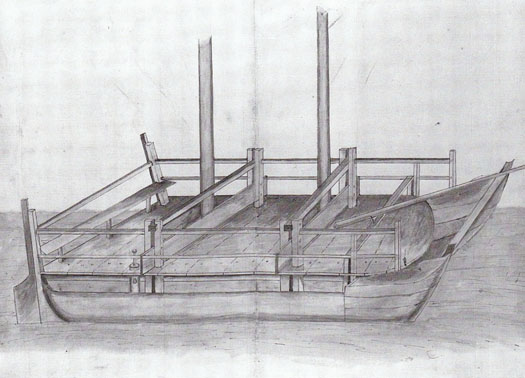
Contemporary drawing of the 17th Century catamaran Simon & Jude, which was built in Dublin and tested in the bay in an early "yacht race" in 1663.
We meanwhile are left wondering just what was this "pleasure boatte" was, and who owned and sailed it. Its existence and good sailing performance seems to have been accepted as unremarkable in Dublin Bay, yet no other record or mention of it has survived.
It was the turbulent life of Munster in the 17th Century which eventually created the conditions in which the first yacht club was finally formed. As the English Civil War spread to Ireland at mid-Century with a mixture of internecine struggle and conquest, the Irish campaigner Murrough O'Brien, the Sixth Baron Inchiquin, changed sides more than once, but made life disagreeable and dangerous for his opponents whatever happened to be the O'Brien side for the day.
Yet when the forces supporting Charles II got back on top in 1660 after the death of Cromwell in 1658, O'Brien was on the winning side. As the dust settled and the blood was washed away, he emerged as the newly-elevated Earl of Inchiquin, his seat at Rostellan Castle on the eastern end of Cork's magnificent natural harbour, and his interests including a taste for yachting acquired with his new VBF Charles II.
But there was much turmoil yet to come with the Williamite wars in Ireland at the end of the 17th Century. Yet somehow as the tide of conflict receded, there seemed to be more pleasure boats about Cork Harbour than anywhere else, and gradually their activities acquired a level of co-ordination. The first Earl of Inchiquin had understandably kept a fairly low profile once he got himself installed in his castle, but his descendants started getting out a bit and savouring the sea. So when the Water Club came into being in 1720, the fourth Earl of Inchiquin was the first Admiral.
In the spirit of the times, having an aristocrat as top man was sound thinking, but this was truly a club with most members described as "commoners", even if there was nothing common about their exceptional wealth and their vast land-holdings in the Cork Harbour area. Much of it was still most easily reached by boat, thus sailing passenger vessels and the new fancy yachts interacted dynamically to improve the performance of both.
Yet there was no racing. Rather, there was highly-organised Admiral Sailing in formation, something which required an advanced level of skill. However, many of the famous club rules still have a resonance today which gives the Water Club a sort of timeless modernity, and bears out the assertion by some historians that, as it all sprang to life so fully formed, the formation date of 1720 must be notional, as all the signs are that there had been a club of some sort for years beforehand.
But either way, it makes no difference to the validity or otherwise of the rival claim, that the Squadron of the Neva at St Petersburg in Russia, instituted by the Czar Peter the Great in 1718 to inculcate an enthusiasm for recreational sailing among Imperial Russia's young aristocrats, was the world's first yacht club. It was no such thing. It was in reality a unit of the Russian navy, and imposed by diktat from the all-powerful ruler. As such, it was entirely lacking the basic elements of a true club, which is a mutual organisation formed by and among equals.
Yet as the Water Club of the Harbour of Cork had no racing with results published in what then passed for the national media, we are reliant on the few existing club records and some travel writing from the time for much of our knowledge of the early days of the Water Club. That, and the Peter Monamy paintings of the Water Club fleet at sea in 1738.
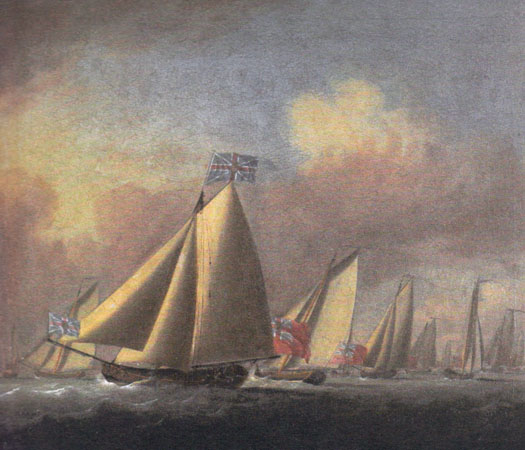
A remarkably well-disciplined fleet. Peter Monamy's 1738 painting of the yachts of the Water Club at sea off Cork Harbour. They weren't racing, but were keeping station in carefully-controlled "Admiral Sailing". Courtesy RCYC
Fortunate indeed are the sailors of Cork, that their predecessors' activities should have been so superbly recorded in these masterpieces of maritime art. The boats may look old-fashioned to a casual observer, yet there's something modern or perhaps timeless in this depiction of the fleet sailing in skilled close formation, and pointing remarkably high for gaff rigged boats as they turn to windward. Only a genuine shared enthusiasm for sailing could have resulted in such fleet precision, and in its turn in a memorable work of art. It is so much part of Irish sailing heritage that we might take it for granted, but it merits detailed study and admiration no matter how many times you've seen it already.
Shortly after Monamy's two paintings were completed, Ireland entered a period of freakish weather between 1739 and 1741 when the sun never shone, yet it seldom if ever rained, and it was exceptionally cold both winter and summer. It is estimated that, proportionately speaking, more people died in this little known famine than in the Great Famine itself 104 years later. While the members of the Water Club would have been personally insulated from the worst of it, the economic recession which struck an intensely agricultural area like Cork affected all levels of society.
Thus the old Water Club saw a reduction in activity, but though it revived by the late 1740s, the sheer energy and personal commitment of its early days was difficult to recapture, and by the 1760s it was becoming a shadow of its former self. Nevertheless there was a revival in 1765 and another artist, Nathanael Grogan, produced a noted painting of Tivoli across from Blackrock in the upper harbour, with a yacht of the Water Club getting under way for a day's recreation afloat, the imminent departure being signalled by the firing of a gun.
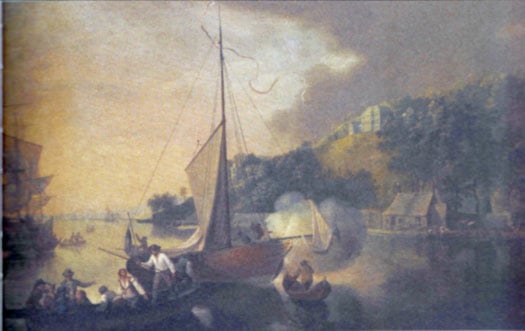
The best way to get the crew on board....on upper Cork Harbour at Tivoli in 1765, a yacht of the reviving Water Club fires a gun to signal imminent departure.
However, it was on Ireland's inland waterways that the next club appeared – Lough Ree Yacht Club came into being in 1770, and is still going strong. That same year, one of the earliest yacht clubs in England appeared at Starcross in Devon, but it was in London that the development pace was being most actively set with racing in the Thames for the Cumberland Fleet. Some members of this group, after the usual arguments and splits which plague any innovative organisation, in due course re-formed themselves as the Royal Thames Yacht Club in the early 1800s. But the famous yet unattributed painting of the Cumberland Fleet racing on the Thames in 1782, while it is slightly reminiscent of Monamy's painting of the Water Club 44 years earlier, undoubtedly shows boats racing. And they'd rules too – note the port tack boat on the right of the picture bearing off to give way to the boat on starboard.
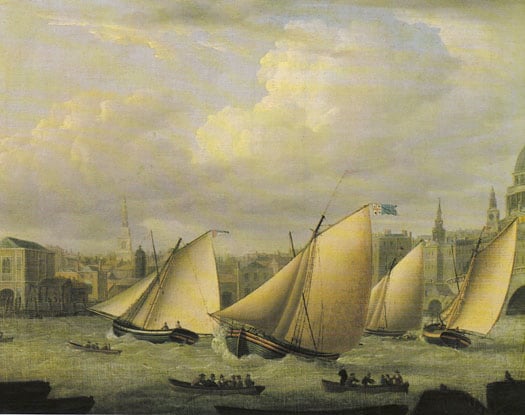
Definitely racing – the Cumberland Fleet, precursor of the Royal Thames Yacht Club, racing in the River Thames at Blackfriars in 1782.
The Thames was wider in those days, but even so they needed strict rules to make racing possible. Dublin Bay offered more immediate access to open water, and there were certainly sailing pleasure boats about. When the Viceroy officially opened the Grand Canal Dock on April 23rd 1796, it was reported that the Viceregal yacht Dorset was accompanied by a fleet of about twenty ceremonial barges and yachts. Tantalisingly, the official painting is almost entirely focused on the Dorset and her tender, while the craft in the background seem to be naval vessels or revenue cutters.
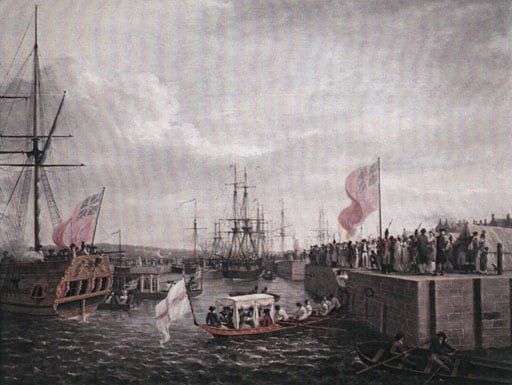
This painting of the opening of the Grand Canal Dock in 1796 tends to concentrate on the ceremonials around the Viceroy's yacht Dorset in the foreground, but fails to show clearly any of the several privately-owned yachts which were reportedly also present....
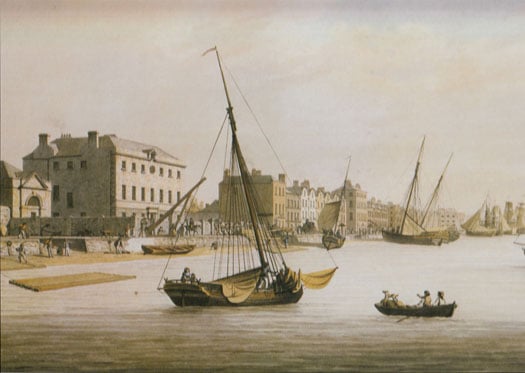
.......but this illustration of the old Marine School on the South Quays in Dublin in 1803 seems to have a yacht – complete with owner and his pet dog on the dinghy in the foreground – anchored at mid-river.
However, a Malton print of the Liffey in 1803 shows clearly what is surely a yacht, the light-hearted atmosphere of waterborne recreation being emphasised by the alert little terrier on the stern of the tender conveying its owner in the foreground Meanwhile in the north of Ireland there was plenty of sailing space in Belfast Lough, while Belfast was a centre of all sorts of innovation and advanced thinking. Henry Joy McCracken, executed for his role in the United Irishmen's rising in 1798, was a keen pioneer yachtsman. As things took a new turn of determined money-making in Belfast after the Act of Union of 1801, some of his former crewmates were among those who formed the Northern Yacht Club in 1824, though it later transferred its activities across the North Channel to the Firth of Clyde, and still exists as the Royal Northern & Clyde YC.
Meanwhile in 1806 the old Water Club of the Harbour of Cork had shown new signs of life, but one result of this was an eventual agreement among members - some of them very old indeed, some representing new blood - that the club would have to be re-structured and possibly even given a new name in order to reflect fresh developments in the sport of yachting. The changeover was a slow business, as it had to honour the club's history while giving the organisation contemporary relevance. Thus it was 1828 before the Royal Cork Yacht Club had emerged in this fully fledged new form, universally acknowledged as the continuation of the Water Club, and incorporating much of its style.
But it was across the north on Lough Erne in 1820 that the world's first yacht club specifically set up to organise racing was formed, and Lough Erne YC continues to prosper today, its alumnae since 1820 including early Olympic sailing medallists and other international champions.
There must have been something in the air in this northwest corner of Ireland in the 1820s, for in 1822 the men who sailed and raced boats on Lough Gill at Sligo had a pleasant surprise. Their womenfolk got together and raised a subscription for a handsome silver trophy to be known as the Ladies' Cup, to be raced for annually – and it still is.
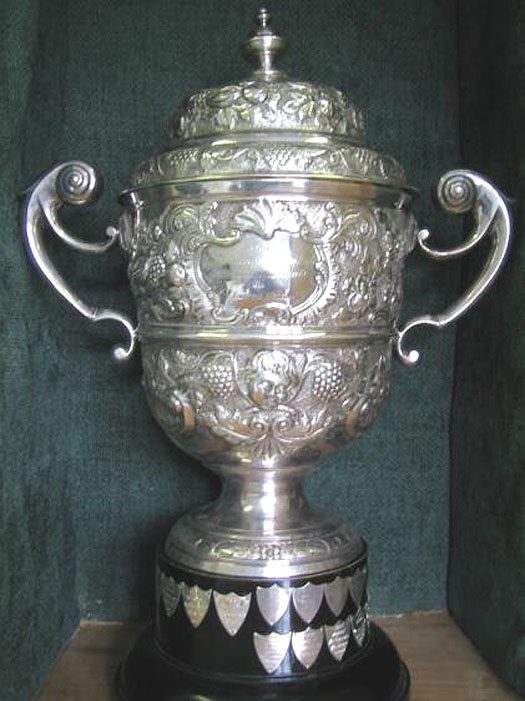
Instituted in 1822, the Ladies' Cup of Sligo YC is the world's oldest continually-contested annual sailing trophy.
Annual challenge cups now seem such a natural and central part of the sailing programme everywhere that it seems extraordinary that a group of enthusiastic wives, sisters, mothers and girlfriend in northwest Ireland were the first to think of it, yet such is the case. Or at least theirs is the one that has survived for 192 years, so its Bicentenary in 2022 is going to be something very special.
Those racing pioneers of the Cumberland Fleet had made do with new trophies freshly presented each year. And apparently the same was the case initially at Lough Erne. But not so very far down the road, at Sligo, somebody had this bright idea which today means that the museum in Sligo houses the world's oldest continually raced-for sailing trophy, and once a year it is taken down the road to the Sligo YC clubhouse at Rosses Point to be awarded to the latest winner – in 2013, it was the ever-enthusiastic Martin Reilly with his Half Tonner Harmony.
The Ladies Cup was won in 2013 by Martin Reilly's Half Tonner Harmony. Pictured with their extremely historic trophy are (left to right) Callum McLoughlin, Mark Armstrong, Martin Reilly, John Chambers, Elaine Farrell, Brian Raftery and Gilbert Henry
However, although the Ladies' Cup may have pioneered a worthwhile trend in yacht racing, it wasn't until 1831 that they thought of inscribing the name of the winner, and that honour goes to Owen Wynne of Hazelwood on the shores of Lough Gill. But by that time the notion of inscribing the winners was general for all trophies, and a noted piece of the collection in the Royal Cork is the Cork Harbour Regatta Cup 1829, and on it is inscribed the once-only winner, Caulfield Beamish's cutter Little Paddy.
The name of noted owner, skipper and amateur yacht designer Caulfield Beamish came up here some time back, when we were discussing how in 1831 he took a larger new yacht to his own design, the Paddy from Cork, to Belfast Lough where he won a stormy regatta. So you begin to understand the mysterious enthusiasm people have for sacred relics when you see this cup with its inscription, and realise that it's beyond all doubt that this now-forgotten yet brilliant pioneer of Cork Harbour sailing development personally held this piece of silverware.
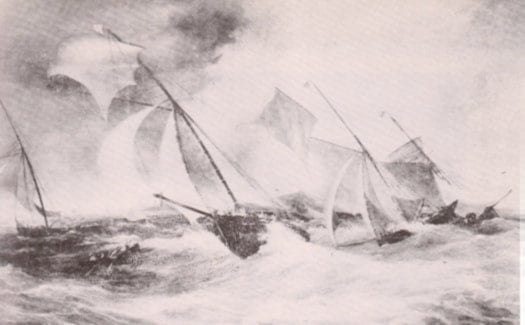
Caulfield Beamish's new cutter Paddy from Cork (which he designed himself) winning a stormy regatta in Belfast Lough in 1831
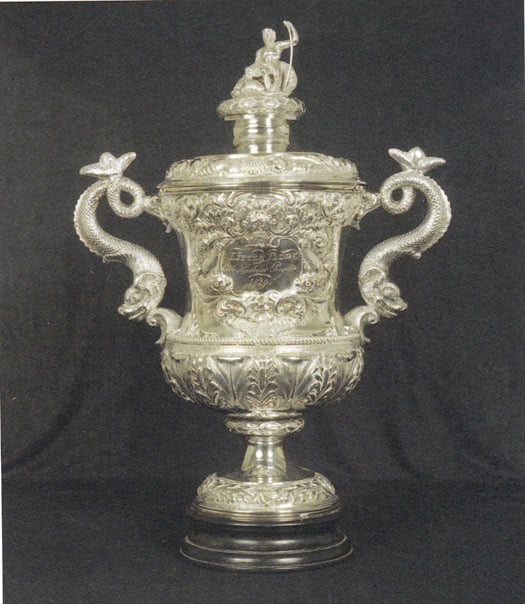
The Cork Harbour Regatta Cup of 1829.....Courtesy RCYC
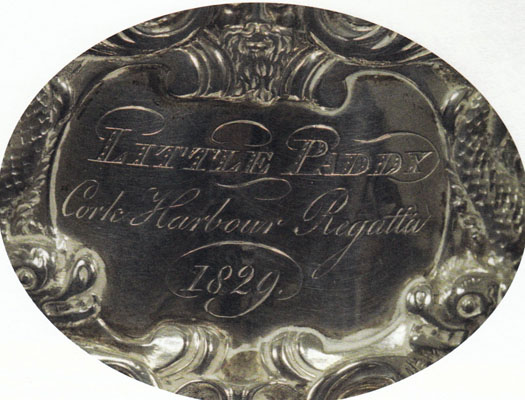
....and on it is inscribed the winner, Caulfield Beamish's earlier boat, Little Paddy, which he also designed himself. Courtesy RCYC
Another pioneer in yacht racing at the time was the Knight of Glin from the Shannon Estuary, who in 1834 was winning all about him with his cutter Rienvelle, his season's haul including a silver plate from a regatta in Galway Bay – it's now in Glin Castle – while he also seems to have relieved fellow Limerick owner William Piercy of £50 for a match race in Cork Harbour against the latter's cutter Paul Pry.
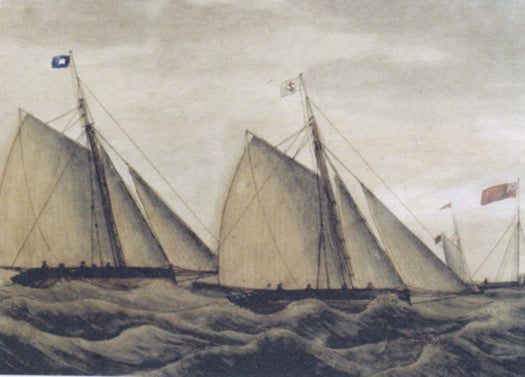
The lads from Limerick hit Cork. William Piercy's Paul Pry racing for a wager of £50 against the Knight of Glin's Rienvelle in Cork Harbour in 1834. When Paul Pry won Cork Harbour Regatta a few weeks later, the band on the Cobh waterfront played Garryowen. Courtesy RCYC
But of all the fabulous trophies in the Royal Cork collection, the one which surely engenders the most affection is the Kinsale Kettle. It goes back "only" to 1859, when it was originally the trophy put up for Kinsale Harbour Regatta. But this extraordinarily ornate piece of silverware was not only the trophy for an annual race, it was also the record of each race, as it's inscribed with brief accounts of the outcomes of those distant contests.
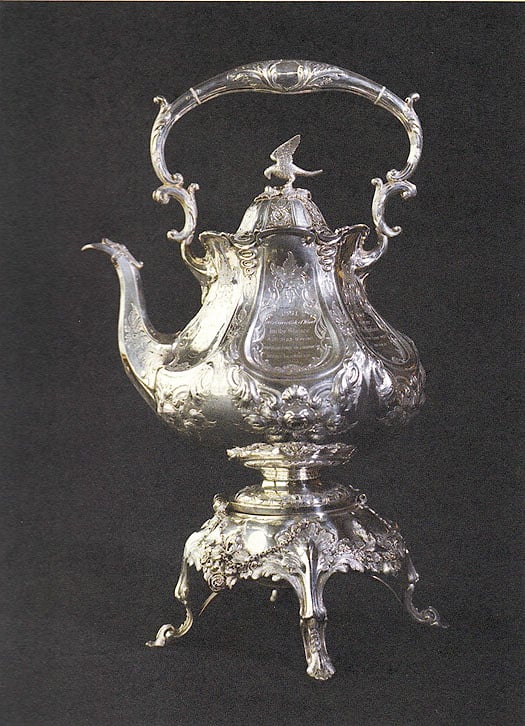
An extraordinary piece of Victorian silverware. The "Kinsale Kettle" from 1859 is now the Royal Cork YC's premier trophy.
Today, it continues to thrive as the Royal Cork Cup, the premier award for Cork Week. The most recent winner in 2012 was Piet Vroon with his superb and always enthusiastic Tonnere de Breskens. The fact that this splendid ambassador for Dutch sailing should be playing such a central role in current events afloat here in Ireland brings the story of our sport's artworks and historical artefacts to a very satisfactory and complete circle.
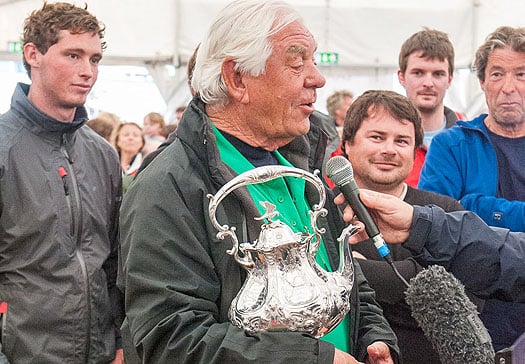
More tea, skipper? The current holder of the Kinsale Kettle, aka the Royal Cork Cup, is Piet Vroon of Tonnere de Breskens. Photo: Bob Bateman
#yachtclubs – A new Dun Laoghaire-based political party, People United in Republican Endeavour (PURE), has launched its campaign for the forthcoming Local Government Elections with demands for changes in the style and names of the leading yacht clubs, both in Dun Laoghaire and throughout Ireland reports W M Nixon.
Introducing a Policy Document on behalf of PURE, the new party's spokesman Mr Hugh Mannity stated: "It makes me suffer to see these unfortunate people, the members of the Dun Laoghaire waterfront yacht clubs, being forced into aping the airs and graces of their former colonial oppressors".
"Despite the imminence of a State Visit to the Queen of England by the President of Ireland, we who are PURE demand that all vestiges of former royal dominance and patronage be removed entirely from every organisation, building and boat in Ireland".
However, Mr Mannity insisted that the changeover would be effected with a minimum of expense. "We know that perhaps the most costly aspect of this fresh new initiative will be in the changing of signs, letterheads and so forth," he said. "In the case of yachts, there would be additional expense in changing the lettering on the hulls denoting the club to which the owner belongs."
The Research Department in PURE has been burning the midnight oil, Mr Mannity claimed, in order to minimise expense, or indeed make it unnecessary altogether. "Thanks to our far-seeing think tank," he said, "the initials for the Royal Irish Yacht Club will stay exactly the same, only now it will be known as the Republic of Ireland Yacht Club".
"Equally, the Royal St George Yacht Club will retain its initials, but the title of the club will be changed to the Religious St George Yacht Club. This is because we in PURE find it doubly offensive that a leading yacht club should have a royal title combined with a political overtone which completely ignores the underlying theme of the sanctity of St George. So we hope to put the holiness back into the club for the good of its members"
"A problem arises with the Royal Alfred Yacht Club. We find it offensive that it should commemorate a now unknown son of the ruthless Queen Empress Victoria. Thus we have decided that, while it should retain its present initials, it should henceforth be known as the Real Alfie Yacht Club, named in honour of the much-loved long-term Lord Mayor of Dublin Alfie Byrne, who was also world-renowned for his pioneering work in moustache research and manipulation."
Mr Mannity continued by stating that his grouping would show its even-handedness by insisting on a change in the title of the National Yacht Club. "While we laud this fine club's lack of any royal associations in its name," he said, "we are concerned that these days too many organisations, in sailing as elsewhere, insist on having "National" in their title, thereby rendering it meaningless. Thus we will expect the NYC to become the TNYC – the True National Yacht Club. We appreciate that this will cause the members some expense, but our Field Researchers who regularly walk Dun Laoghaire's East Pier with their whippets tell us that, judging by the boats stored in the club's forecourt, the members could well afford to lay out the money on a 'T'."
When questioned about PURE's intentions regarding the Royal Cork Yacht Club, Mr Mannity said he did foresee a special problem. The Republic of Cork already existed within the Rebel County, and re-naming the club would be a matter of whether or not it became the Republic of Cork Yacht Club, or the Rebel County Yacht Club. "There could well be blood in the streets over that one" he admitted.
However, in order to show the depth of research undertaken by PURE's think tank on this entire matter, Mr Mannity pointed outthat not many people were aware that within the Royal Cork YC's present structure, the old Royal Munster Yacht Club still existed, and was recognised by the role of Commodore in the RCYC officer board, along with the Admiral.
"We feel that too many problems would be created by trying to establish a Republic of Munster in order to facilitate the existence of a Republic of Munster Yacht Club. Thus we have decided it should be re-titled the Province of Munster Yacht Club. We realise that this will necessitate a small change in the initial letter. But where some traditionalists still have RMYC across the sterns of their boat, we would point out that changing it to PMYC would only involve painting out one little leg of the letter 'R'. However, to show our goodwill, a small phial of white paint will be provided to owners to facilitate the change. We realise that this will only work with white boats. But the Irish taxpayer cannot be expected to fork out hard-earned cash for the awkward minority who insist on parading about on the ocean in boats coloured Mediterranean Blue or Sunset Red or whatever, when any civilised person knows that all proper yachts are white".
In concluding his PURE statement, Mr Mannity admitted that the root of the problem in creating a Republic of Munster lay in the continuing existence of the Kingdom of Kerry. "We're not crazy" he asserted. "We know that trying to subsume Kerry into a new Republic in a combination with Cork would be a step too far".
"Nevertheless we feel strongly that it is time and more for the good people of Kerry to reconsider their claims to the status of being a monarchy. Thus we propose what we feel will be a real vote getter. We plan to re-position Kerry as a Duchy. And plans are well advanced to request a noted KiIgarvan family to become the hereditary Dukes of Kerry. We feel sure that this brilliant innovative idea will be a surefire runner"
#corkharbour – Camden Fort Meagher, an historic fort in Cork Harbour will headquarter June's International Sailing event for women hosted by Royal Cork Yacht Club it was announced yesterday. An Irish team for the event has yet to be anounced due to late changes in the selection process.
Sixteen international teams are expected to travel and compete and will include some of the world's highest ranking sailors and potential Olympians. Entries to date have been received from New Zealand, United States, Denmark, France and the Netherlands. As Afloat reported earlier the event will also be the first stage of the Women's International match Racing Association tour.
Sponsored by Cork County Council and the Port of Cork, the World Match Racing Championship for Women is one of the world's highest calibre sporting events.
Cork Harbour renowned for its sailing throughout the world, is hosting this event directly under Camden Fort Meagher, which offers unrivalled viewing to competitors, their families, friends, supporters and general public.
Camden Fort Meagher will be the Event Head Quarters for this international sailing event. This will be a first for the fort. Paul Brierley, project coordinator for Camden Fort Meagher said "we are delighted to be part of this world event, which will allow competitors and spectators to enjoy the wonderful ambience of this historic fort and an ariel view of the racing from its spectacular deck". Royal Cork Yacht Club Admiral, Pat Lyons, explains that "Cork and the Royal Cork Yacht Club were chosen over other locations, such as Long Beach California". "This speaks volumes" he said, "of the commitment and expertise we have in the yacht club and in Crosshaven to be chosen to host such a prominent event here in Cork Harbour".
However not all the sailing will take place in the harbour from the 3rd to 8th of June. On 6th of June the River Lee will play host to a one day event, which will bring the international sailing competition into the heart of Cork City for everyone to enjoy.
Cork County Council and the Port of Cork have come together as Joint Title Sponsors to support this prestigious international sailing even. In recent times both Cork County Council and Port of Cork have invested heavily in the harbour area; promoting sailing and other water based activities to aid development of the harbour. Cork's natural harbour is not only a place to do business, but an attractive tourist destination which offers so much to visitors.
Event Chairman, Ronan Enright, comments "We are delighted with the support that has been shown by our sponsors Cork County Council and the Port of Cork. This sponsorship is not only promoting women's sailing, it is also providing a once in a life time experience within the unique setting of Camden Fort Meagher to both competitors and spectators"
Royal Cork's Dinghy PY 500 Regatta Success in Cork Harbour
#rcyc – Weather obliged beautifully for PY 500 making a perfect Sunday morning event at Royal Cork Yacht Club writes Claire Bateman. And what a magnificent spectacle the PY500 (Portsmouth Yardstick) race turned out to be. The sun was shining and there was a Westerly breeze of some 15 knots lightening slowly during the race. The course was Windward/Leeward around laid marks and consisting of seven rounds.
The event consisted of a mixed dinghy race for vessels holding a PY Handicap of 700-1320. Results are downloadable below as a jpeg file.
Due to the thirty one boats participating and the different speeds involved there were officials in position at each mark to record each competitor rounding for each of the seven rounds. Due to the location of the course up and down the river outside the club magnificent spectator viewing was provided for the large numbers present.
There were many boats from different classes represented and they certainly provided spectacular viewing.
The representatives were from National 18s, 505's, RS 400, RS 200, a lone Finn, Fevas, Fireflies, Lasers of all rig types, a Rankin and the star of the show, a 29er that charged around the course showing such style with a fluorescent orange Gennaker. Spotted sailing his RS 200 with his wife Heather was Sean Craig from the RstGYC. Also sailing from the RCYC's own club boats were 2 Topaz, one Magno and one Omega.
In between all this flying action there were Optimsts, 420s and 1720s all setting out for training and all in all there was a tremendous buzz in the club.
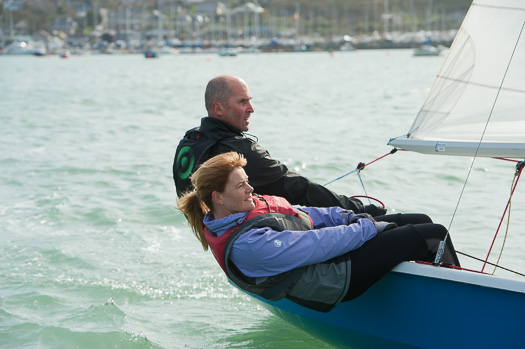
Sean and Heather Craig travelled from Dun Laoghaire for Royal Cork's PY 500. More photos by Bob Bateman below.
It must have made interesting and delightful viewing in the lovely conditions for the members and friends arriving for Sunday lunch at the Club's Globe Restaurant.
All credit due to the organisers and so obviously successful and enjoyable they might consider a repeat performance.
Sail Cork Sailing School Celebrates Forty Years in Business at Royal Cork Yacht Club Gala
#sailcork – On Saturday night last the Royal Cork Yacht Club was buzzing for a delightful evening of chat, fun, meeting old friends and generally having a great time writes Claire Bateman. The night also marked the official handing over of certificates to all who had successfully completed their navigation or yacht master courses which are conducted by Sailcork at the club throughout the year and Eddie and Jo English took this occasion to celebrate Sailcork's fortieth anniversary with a magnificent dinner held in Royal Cork's newly named dining room 'The Globe Restaurant'. Special guests included Royal Cork Admiral, Pat Lyons and the Admiral's Lady, Ann. From Dublin came the Commodore of the Royal St.George Yacht Club, Commodore Liam O'Rourke and joining these special guests were Commodore Adrian Tyler from Cove Sailing Club and his delightful wife Teresa.
Following the meal and with everybody in the mood to enjoy Eddie's special presentation of a digital slide show all present settled down to be treated to a history not only of Sailcork and its forerunner, The International Sailing Centre, but he also took the captivated audience right back to Cork Harbour's history of sailing from the year 1664. There were many cheers and guffaws from members of the audience who recognized themselves on the screen in photographs from many years back. Commodore O'Rourke gave a very entertaining talk on his long association with Eddie and entertained the audience greatly with tales of their exploits over the years in the Caribbean.
The very successful evening was brought to a close with a hilarious presentation by Captain Anthony Mulcahy, Port of Cork Harbour Pilot, giving a picture, no doubt highly embellished, of what it was like to work with Eddie over the years and this drew howls of laughter from the audience. Anthony 's current role with Sailcork is providing tuition in VHF communications. He certainly had no difficulty in communicating with his very receptive audience last night.
All in all a great evening was enjoyed by everyone present.
The school recently won a sailing award in Afloat's inaugural Maritime Web Awards in December.



























